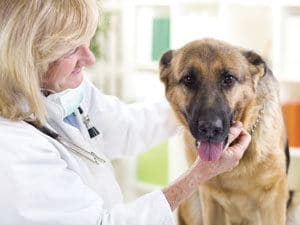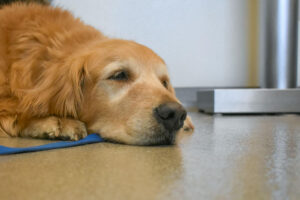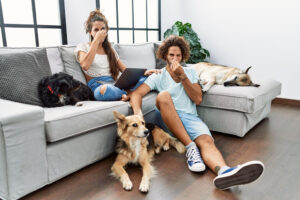
Vet visits are an essential part of every dog’s life, if only for routine check-ups and yearly vaccinations. With a little careful preparation they needn’t be traumatic — for your dog or you! If you can make your puppy’s first vet visit relaxed, she won’t develop anxiety about future appointments.
Your puppy should be comfortable with being touched. Dogs aren’t naturally comfortable with having their tail lifted or their belly, feet, and nails touched. Find a time when your puppy is relaxed and calm and get him used to these actions. If it’s something that he becomes accustomed to with you, he’ll feel more at ease at the vet’s office. Here are some steps you can take to make it easier for both of you.
1. Check Your Own Anxiety
On the day of the visit, it’s really important that you remain calm because your dog will pick up on any tension. Even if you have to fake it, put on a happy face and try to keep everything cheerful. As much as possible stick to your regular routine.
2. Calming Scents
Remember: dogs think through their noses. Lavender and some other natural scents are known to have a calming effect. Spray some in the back of the car or on a cushion or towel to take with you. It doesn’t hurt to have some on your hands too.
3. Take Some Car Rides
Don’t use a carrier that you only bring out for trips to the vet! Instead, leave it out somewhere in the house so your dog will become familiar with it and won’t hide the moment he sees it. If your dog isn’t used to being in the car, take several short trips beforehand — preferably ones that end with a fun event, like a walk in the park.
4. Use Treats
Have your pet’s favorite treats on hand to encourage him. These will be more effective still if your pup is a little hungry. If possible, hold off on his regular feeding before you go.
5. Resist Petting
If your dog gets nervous during any part of the vet visit, resist the urge to pet him and tell him everything is okay. This will only reinforce his nervousness because he’ll think you’re rewarding his behavior.
6. Have An Early Visit
If possible it’s a good idea to take your pup to the vet’s office before the day of the appointment to let him become familiar with the waiting room. Remember, a veterinarian’s office is full of strange scents. An early visit will give him a chance to get used to them without any negative association.
7. Stay Aware of Symptoms
Do your part. Remember, dogs can’t talk to the doctor. Make a list of any symptoms you may have noticed — from loss of appetite to difficulty walking, a change in his bark, or anything else that seems out of the ordinary.
8. Ask Questions!
Think of any questions you have for the vet before you go to the appointment — and be sure to ask them. Keep your own record of vaccinations so you can be sure they’re all up to date.
Lastly, don’t be shy! If your vet prescribes medication or a course of treatment, ask her to demonstrate the correct way to administer it.
Have tips of your own? Tell us your secrets for a peaceful vet visit.











